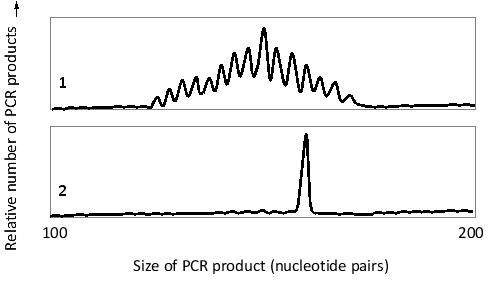A patient with persisting larger-than-normal lymph nodes is suspected to have a T cell lymphoma, a cancer of T lymphocytes. Abnormally enlarged lymph nodes are also found in local infections, when lymphocytes are activated to proliferate there. In order to distinguish between cancer and infection, you take tissue samples from the patient, as well as from a healthy individual, and perform a so-called clonality test. You extract DNA from the tissues and amplify a small chromosomal region that includes the T-cell-receptor ? chain D-J junctions. Amplification is done by PCR, using primers that hybridize to specific DNA sequences flanking the junctions. You then analyze the size distributions of the PCR products by capillary electrophoresis, which makes it possible to distinguish between DNA molecules with small differences in size. Based on the results, presented in the following schematic graphs, you conclude that, unfortunately, it is likely that the patient has developed a T cell lymphoma. Which graph (1 or 2) represents the patient's test results? Write down 1 or 2 as your answer.

Correct Answer:
Verified
View Answer
Unlock this answer now
Get Access to more Verified Answers free of charge
Q37: Indicate true (T) and false (F) statements
Q38: How many hypervariable loops are there in
Q39: Where are the hypervariable regions located in
Q40: Consider two solution chambers of equal volume
Q41: Indicate whether each of the following cell-surface
Q42: The schematic drawing below summarizes the differentiation
Q43: Sort the following events to reflect the
Q44: Different mice have different allelic variants of
Q45: In the following schematic diagram, which curve
Q46: From an evolutionary perspective, which mating pattern
Unlock this Answer For Free Now!
View this answer and more for free by performing one of the following actions

Scan the QR code to install the App and get 2 free unlocks

Unlock quizzes for free by uploading documents